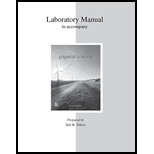
Concept explainers
Earthquake data from a subduction zone are shown in the following table. What is the slope of the subducting plate in m/km?
Distance from Trench (km) |
Earthquake Depth (km) |
|
1 |
12.1 |
4.2 |
2 |
25.4 |
9.1 |
3 |
33.2 |
11.8 |
4 |
48.6 |
17.6 |
5 |
75.7 |
28.4 |
The slope of the subduction zone in m/km.
Answer to Problem 14PEB
Solution:
The average slope of the subduction zone is
Explanation of Solution
Given data:
The following data has been provided:
Distance from Trench (km) |
Earthquake Depth (km) |
|
1 |
12.1 |
4.2 |
2 |
25.4 |
9.1 |
3 |
33.2 |
11.8 |
4 |
48.6 |
17.6 |
5 |
75.7 |
28.4 |
Formula used:
Write the expression for slope.
Here,
Write the expression for the average slope.
Here,
Explanation:
The upper surface of the subduction plate is delineated by the earthquake foci and thus the distance of the earthquake from the trench and the depth can be used to determine the slope of the subducting plate. Consider the depth of earthquake on the
Case 1: Convert
Here,
Calculate the slope when the earthquake depth is
Substitute
Consider case
Case 2: Convert
Calculate the slope when the earthquake depth is
Substitute
Consider case
Case 3: Convert
Calculate the slope when the earthquake depth is
Substitute
Consider case
Case 4: Convert
Calculate the slope when the earthquake depth is
Substitute
Consider case
Case 5: Convert
Calculate the slope when the earthquake depth is
Substitute
Now, calculate the average slope of the subducting plate.
Substitute
Conclusion:
The average slope of the subduction zone is
Want to see more full solutions like this?
Chapter 18 Solutions
Lab Manual for Physical Science
Additional Science Textbook Solutions
MODERN PHYSICS (LOOSELEAF)
Physics for Scientists and Engineers, Technology Update (No access codes included)
Conceptual Physical Science (6th Edition)
Cosmic Perspective Fundamentals
Tutorials in Introductory Physics
- If you wanted to live where the chances of a destructive earthquake were small, would you pick a location near a fault zone, near a mid ocean ridge, near a subduction zone, or on a volcanic island such as Hawaii? What are the relative risks of earthquakes at each of these locations?arrow_forwardWhat process during plate collisions leads to the formation of volcanic islands arcs? (21.4) (a) remanent magnetism (b) seismic waves (c) subduction (d) isostasyarrow_forwardDistinguish among a normal fault, a reverse fault, and a transform fault.arrow_forward
 AstronomyPhysicsISBN:9781938168284Author:Andrew Fraknoi; David Morrison; Sidney C. WolffPublisher:OpenStax
AstronomyPhysicsISBN:9781938168284Author:Andrew Fraknoi; David Morrison; Sidney C. WolffPublisher:OpenStax An Introduction to Physical SciencePhysicsISBN:9781305079137Author:James Shipman, Jerry D. Wilson, Charles A. Higgins, Omar TorresPublisher:Cengage Learning
An Introduction to Physical SciencePhysicsISBN:9781305079137Author:James Shipman, Jerry D. Wilson, Charles A. Higgins, Omar TorresPublisher:Cengage Learning

